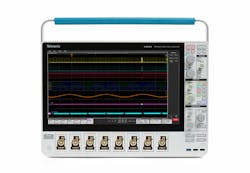Oscilloscopes are one of the true workhorse instruments, available over a wide range of performance levels and prices. But why use a state-of-the-art instrument for troubleshooting when a general-purpose oscilloscope will do just as well? With measurement power and performance comes price, and by matching an oscilloscope’s capabilities to the expected needs of a set of applications, an optimum match can be made between price and performance.
When searching for an oscilloscope, the number of choices can be intimidating. Many offer advanced digital features, although even the latest digital models start with analog front ends. Those analog front ends establish an oscilloscope’s bandwidth, which sets the highest frequency signal that can be accurately measured, no matter what the sampling rate. Bandwidth is a key parameters to consider when shopping for an oscilloscope. Other important parameters relate to an oscilloscope’s digital circuitry, such as sampling rate and sampling bit resolution. By considering the types of waveforms to be measured, adequate oscilloscope measurement power can be specified without going overboard on performance or price.
A typical benchtop digital sampling oscilloscope (DSO) is characterized by its bandwidth, sampling rate, bit resolution, number of channels, and signal acquisition memory. The bandwidth of the analog front end acts like a bandpass filter for input signals, with a bandwidth usually specified by a 3-dB passband. Signals outside of the passband are attenuated by more than 3 dB and distorted, with poor measurement results.
In theory, measuring a 100-MHz analog CW signal with a 100-MHz oscilloscope will show a signal amplitude about 3-dB less expected. To accurately measure such a CW signal, a bit more oscilloscope bandwidth is needed (such as 150 MHz), so that the signal is not attenuated by the oscilloscope’s frequency response.
Truly portable oscilloscopes make it possible to bring the instrument to the measurement. (Courtesy of Tektronix)
Oscilloscopes typically use two types of sampling: repetitive and single-shot or real-time sampling. Repetitive sampling collects data on a waveform by accumulating samples along different points per cycle of a waveform with constant amplitude. Real-time sampling takes a number of single-shot samples of a single waveform as a way of reconstructing a waveform with rapidly changing amplitude, such as a pulse and its rise time. The sampling rate may be different for the two techniques, just as the sampling rate can apply to one or two channels, and the sampling rate decreases with division among the channels as more channels are used.
The dynamic range of an oscilloscope is a function of the sampling bit resolution. Oscilloscopes typically use ADCs with 8 to 14 b for sampling. The number of bits is the number of steps available to represent the voltage of a measured waveform. If n is the number of bits, the number is steps is 2n. An oscilloscope with 8-b resolution provides voltage measurements in 256 steps. For rapidly changing waveforms, or voltage with wide dynamic range, more steps and higher (than 8 b) resolution will be needed.
Oscilloscopes can be built for the benchtop or portable. Some are meant as benchtop units but designed for transportability while some allow an engineer to bring the oscilloscope to the measurement, such as in-the-field measurements. A choice of oscilloscope should consider such requirements, especially since many portable oscilloscopes offer performance that equal benchtop levels.
Any choice in oscilloscope can be aided by knowledge about the signals to be measured. Selecting an oscilloscope always involves tradeoffs in performance versus price. But by knowing more about the measurement requirements, the amount of oscilloscope performance can be specified for those measurements. Specifying an oscilloscope can also be made a little less risky by trying an instrument first as a rental. A number of companies, including
Axiom Test Equipment (www.axiomtest.com), Electro Rent (www.electrorent.com) , and TestEquity (www.testequity.com), rent or lease oscilloscopes from leading test-equipment manufacturers, allowing those searching for an oscilloscope “to try before they buy.”
About the Author
Jack Browne
Technical Contributor
Jack Browne, Technical Contributor, has worked in technical publishing for over 30 years. He managed the content and production of three technical journals while at the American Institute of Physics, including Medical Physics and the Journal of Vacuum Science & Technology. He has been a Publisher and Editor for Penton Media, started the firm’s Wireless Symposium & Exhibition trade show in 1993, and currently serves as Technical Contributor for that company's Microwaves & RF magazine. Browne, who holds a BS in Mathematics from City College of New York and BA degrees in English and Philosophy from Fordham University, is a member of the IEEE.

